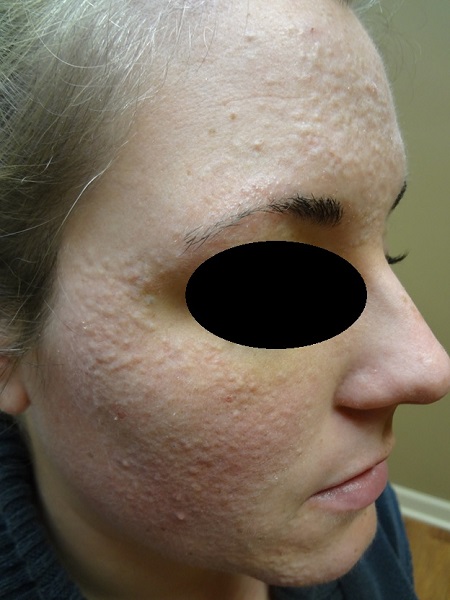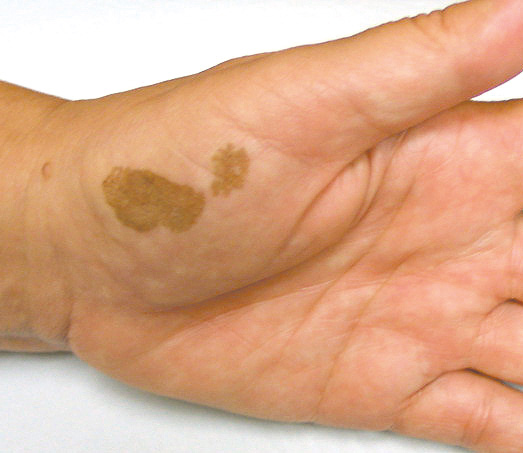CORRECT DIAGNOSIS:
Eruptive Vellus Hair Cysts
DISCUSSION:
First described by Esterley, et al in 1977, eruptive vellus hair cysts are characterized by numerous, small, skin-colored to a darkly pigmented dome-shaped papules occurring most often on the trunk. [1] However, there are reports of EVHC occurring on the face as seen by Reep, et al; Kumakiri, et al; as well as in our patient. [2][3]
The exact pathogenesis of EVHC is unknown, but there have been several proposed theories. Esterley, et al proposed a developmental anomaly of the vellus follicle that leads to occlusion at the infundibular level, thus causing retention of both keratin and hair.[1] Kumakiri, et al proposed that EVHCs arise as a hamartoma of the pilosebaceous unit. [3]
EVHC formation is generally considered a sporadic event. There have been several case reports that suggest an autosomal dominant inherited variant. Steifler, et al reported a case of EVHCs in four siblings in the setting of a mother who had similar lesions in early adulthood.[4] Peipkorn, et al also reported a case of a mother and two of four children with EVHCs on trunk, buttocks and extremities.[5] Recently, Rodgers, et al described a 12 y.o. boy and his 8 y.o. sister who presented with EVHCs on the chest.[6] Our presentation of a patient with the onset of EVHCs on the face in the setting of a father with the same characteristic presentation further supports the role of familial autosomal dominant inheritance in certain cases in the development of EVHCs.
TREATMENT:
Various treatment options exist for EVHCs, each of which has varying levels of success. Topical treatments include retinoic acid and 12% lactic acid preparations. [9,10] Mechanical treatments that have been used in the past consist of CO2 laser ablation with manual lateral pressure to remove the cyst [8] , dermabrasion, and curettage. Kaya, et al had developed their own seemingly effective extraction technique in which there was no recurrence after 4 months following treatment. [7]
Our patient has tried various topical retinoid regimens, none of which have been beneficial. Currently, she is taking oral Isotretinoin 40mg daily and has seen minimal improvement after two months of therapy. Mechanical treatment options have been discussed with the patient including manual cyst extraction as well as CO2 laser therapy. At this time the patient preferred to continue with her present topical and systemic medical treatment options.
REFERENCES:
1: Esterly NB, Fretzin DF, Pinkus H. Eruptive vellus hair cysts. Arch Dermatol. 1977;113:500-3
2: Reed, Michael D., and Kristi J. Robson. “Eruptive Vellus Hair Cysts Presenting as Multiple Periorbital Papules in a 13-Year-Old Boy.” Pediatr Dermatol 13 (2002): 26-27. Web.
3: Kumakiri M, Takashima I, Iju M, Nogawa M, Miura Y, Eruptive vellus hair cysts: a facial variant. J Am Acad Dermatol 1982;7:461-467.
4: Steifler RE, Bergfeld WF. Eruptive vellus hair cysts – an inherited disorder. J Am Acad Dermatol 1980;3:425-429.
5: Piepkorn MW, Clark L, Lombardi DL. A kindred with congenital vellus hair cysts. J Am Acad Dermatol 1981;5:661-665.
6: Rodgers SA, Kitawaga K, Selim MA, Bellet JS. Familial eruptive vellus hair cysts. Pediatr Dermatol 2012 May-Jun;29(3):367-369.
7: Kaya TI, Tataroglu C, Tursen U, Ikizoglu G. Eruptive vellus hair cysts: an effective technique for treatment and diagnosis. J Eur Acad Dermatol Venereol 2006 Mar;20(3):264-268.
8: Fernandez-Torres R, Del Pozo J, Castineiras I, Sacristan F, Mazaira M, Fonseca E. Treatment of multiple eruptive vellus hair cysts with carbon dioxide laser vaporization and manual lateral pressure. Clin EXp Dermatol 2009 Dec;34(8):e716-718.
9: Fisher DA. Retinoic Acid in the treatment of eruptive vellus hair cysts [letter]. J Am Acad Dermatol 1981;5:221
10: Held JL, Andrew JE, Toback AC. Eruptive vellus hair cysts. Cutis 1987;40:259-260.




